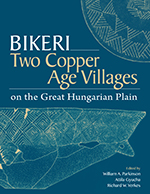Particle-size data from pipette analyses of selected samples from the Bikeri area, the Sebes-Körös floodplain near Vésztő-Mágor and the town of Körösladány, and the surrounding area
Notes
Particle-size analyses for a sequence of cores taken across the first abandoned meander to the west of Körösladány.
Item record
Documentation
Landscape and soil investigation methods
Tod A. Frolking first joined the Körös Regional Archaeological Project during the 2001 field season in Hungary. With the help of students and graduate assistants from the project, soils and sediments in the immediate vicinity of the Vésztő-Bikeri site were cored in late June and early July 2001. In addition, several unsuccessful forays were conducted in search of paleochannel remnants with peat deposits to the east of Vésztő. The following year, a systematic coring campaign was carried out under very dry conditions in late June and early July. During that period: (1) additional surfaces surrounding the Vésztő-Bikeri and Körösladány-Bikeri sites were cored to better characterize local stratigraphic and pedological relationships; and (2) the abandoned channel meanders adjacent to the floodplain of the Sebes-Körös in the vicinity of Vésztő-Mágor were cored to establish pre-canalization channel morphology and floodplain stratigraphy. A total of 168 samples were taken from 33 coring sites.
In July 2005, exceptionally wet conditions prevented access to many floodplain and channel sites during the first week of fieldwork. Subsequently, several paleomeander channels and adjacent floodplain surfaces of the Sebes-Körös and Hármas-Körös were examined and cored along a 60 km section upstream to Zsadány and downstream to Gyomaendrőd. A total of 69 samples were taken from 15 coring sites. Particle-size analyses for a sequence of cores taken across the first abandoned meander to the west of Körösladány are included here in Appendix I.
Field and Lab Methods
Continuous 1.8 cm-diameter cores of soil and sediment were extracted with an Oakfield hand coring tool. Many of the more cohesive silty clay profiles required vigorous pounding with an impact hammer to penetrate into the subsoil. In the vicinity of the Vésztő-Mágor tell, Sebes-Körös River channel deposits extended to depths of 3.5 to 4 m below the floodplain surface. Therefore, when possible, floodplain cores were taken to depths of about 4.5 m. Most sites situated on rises and flats, where no significant subsurface stratigraphic boundary was apparent, were cored to about 3 m. In some cases, the high resistance of the sediment prevented coring to the desired depth. Hand coring, while allowing for mobility and sampling of a relatively large number of sites, severely limits the observation of structures and boundary conditions of soils and sediments. Based on coring, soil profile differences and sedimentary structures appear to be quite subtle in this low-relief landscape of fine-textured sediments. Nonetheless, test trenches at selected locations undoubtedly would provide many more insights into the evolution of the soils and terrain.
The locations of core sites near the Vésztő-Bikeri and Körösladány-Bikeri sites were recorded using a total station. At locations outside the immediate vicinity of the two Early Copper Age settlements, a handheld GPS unit, 1:10,000 topographic maps, surveying tapes, and hand levels were used to plot the coring sites. Soil properties of the core samples include color, mottling, texture, apparent sedimentary boundaries, and special features, such as carbonate concretions and laminations. All reported soil and sediment colors were taken moist using a Munsell soil color chart. Typically, 10 to 15 cm core sections from key soil horizons and stratigraphic layers were sampled for particle-size analysis (Appendix I). For subsoil sections, these 10 to 15 cm core samples did not allow for differentiation of coarser laminations and the finer bulk sediment. Subsampling and particle-size analysis of separate laminations could provide additional information on the depositional environment of subsurface materials but was beyond the scope of this study and would require sampling from test trenches to adequately characterize the sediments. Samples containing significant soil organic matter or charcoal for possible 14C dating were treated separately and wrapped in aluminum foil.
Particle-size analysis utilized sieves for fractions coarser than 62 μm and the pipette method for successive silt and clay fractions based on the phi scale (Gee and Bauder 1986). To promote disaggregation and to obtain size distributions of primary materials, organic-rich samples were pretreated with H2O2 and samples rich in secondary carbonates were treated with 1 N HCL. The median particle diameter (D50) on a mass basis for each sample was determined graphically by first plotting cumulative values (percent finer than) for each successive phi measurement, then connecting successive points with straight line segments, then determining the fiftieth percentile value along the appropriate line segment, and then converting that phi value to its equivalent diameter in microns. The D50 parameter provides a useful indicator for comparisons of the textures of different samples but only provides an approximate mean particle size because of uncertainty concerning the distribution of particle sizes within each phi class. The following particle-size breaks were utilized: ~12φ = 0.2 μm, 9φ = 2 μm, 7φ = 8 μm, 6φ = 16 μm, 5φ = 31 μm, 4φ = 63 μm, 3φ = 125 μm, 2φ = 250 μm, 1φ = 500 μm.
Organic carbon was determined gravimetrically by collection of evolved CO2 onto an NaOH-coated absorbent after combusting the sample in a scrubbed oxygen gas train at 950°C. Calcite equivalent contents of calcareous samples were determined by CO2 evolution using a Chittick apparatus following the methodology of Dremanis (1962). Carbon isotope ratios of charcoal fragments and soil humates were analyzed by Beta Analytic following standard procedures.
Reuse
Frolking, Tod A., 2021. Appendix I: Particle-size data from pipette analyses of selected samples from the Bikeri area, the Sebes-Körös floodplain near Vésztő-Mágor and the town of Körösladány, and the surrounding area for Bikeri: Two Copper-Age Villages on the Great Hungarian Plain. Version 1. Cotsen Institute of Archaeology Press. https://doi.org/10.25346/S6/6EEJAH
